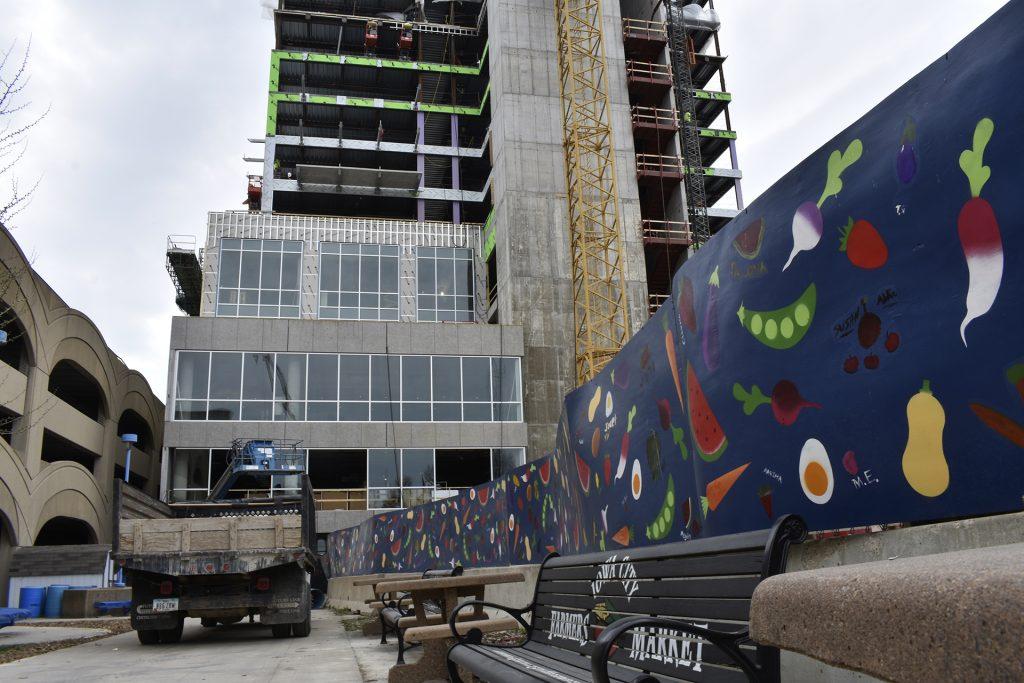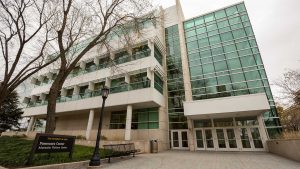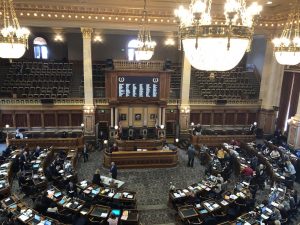Banerjee: What does progress actually look like in Iowa City?
Torn between wanting to support a growing city and finding the new personality of the infrastructure jarring, deciding what progress looks like seems exceedingly hard to determine.
The Chauncey Building is currently under construction on Tuesday, May 1, 2018. The construction will continue as the Iowa City Farmer’s Market commences for the season.
April 16, 2019
Describing what Iowa City is to friends unfamiliar with the area is strangely difficult. I often do not know how to begin talking about this city and why I care so much about it. Is it a small town, interconnected and vibrant, or is it a burgeoning city ready to expand, as the name suggests? Is there even a necessary binary between the two?
I tried to describe Iowa City’s artistic and historical importance to a friend in Massachusetts, but to her mind, it was hard to conceive of something so removed from the heart of seemingly any major community — an urban heart — that is nonetheless thriving.
RELATED: Iowa ranks third in structurally deficient bridges
It is this paradox that makes Iowa City unique. The community, and specifically the art community, is what drew me here and what ultimately made me stay when I considered leaving. But, the face of Iowa City, and how its community exists, is changing rapidly, and I am unsure how I am supposed to react.
The urbanization of Iowa City has its clear purposes and benefits, and much of the marketing behind it makes sense on an intellectual level. In order to develop our city, we need more living space, more entertainment, more public spaces — we need to get bigger and taller so others in the Heartland and outside of it can see us.
So we are constructing beacons to call out our presence. In this way, the new Chauncey building is in many ways the physical manifestation of my anxieties, the fulcrum in the question of whether or not this progress is dangerous. It is certainly the tallest beacon by far and the most ambitious.
RELATED: Neal: Restaurants dominate the landscape of Iowa City — let’s respect the people who operate them
When it is being sold to artists and like-minded people, it is praised for its interest in creating an even more vibrant art community in Iowa City by building the greatest small city for the arts. The new FilmScene at the base of the monolith is glass-encased and transparent. It will be filled with thousands of lights, and colors, and pieces of popcorn. But I do not completely recognize what I love about Iowa City in it.
I am not against progress. I try not to be too much of a reactionist when I consider new infrastructure or building. There is a clear purpose of progress, and I want the opportunities that the new Chauncey will afford the community, especially the film and art community. But, nonetheless, knowing that the “arts” will exist in a building almost no one can afford to live in is ideologically incomprehensible for me. I do not know exactly how this building will go to define a community — or if it should try to define a community like this in the first place.
I care about the new opportunity this will afford Iowa City, but are high-rises the natural cost for this? Does progress have to look like this? I don’t know the answers to my questions, and I don’t know the right course of action.
RELATED: The future of Dodge Street includes a massive construction project slated for 2023
All I know is that my gut feeling is an abiding sense of discomfort. When caught between a fading Englert whose structure can barely keep housing its purposes and a shiny new building that feels distanced from the community it wants to help, I don’t know where I should land. Your answer is as good as mine, but I do know that I want to spend my energy listening to a community that calls out for affordable or better housing, for more resources, for improved safety measures, for relief for poverty rates rather than developers who see Iowa City as a revenue opportunity.






